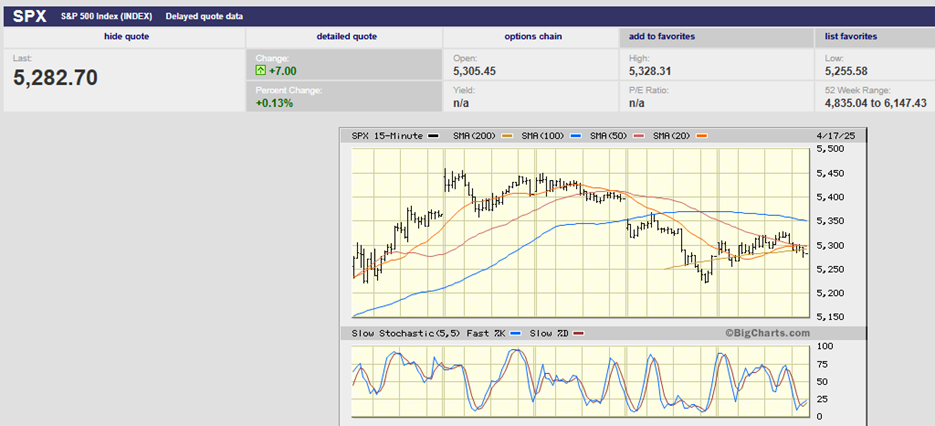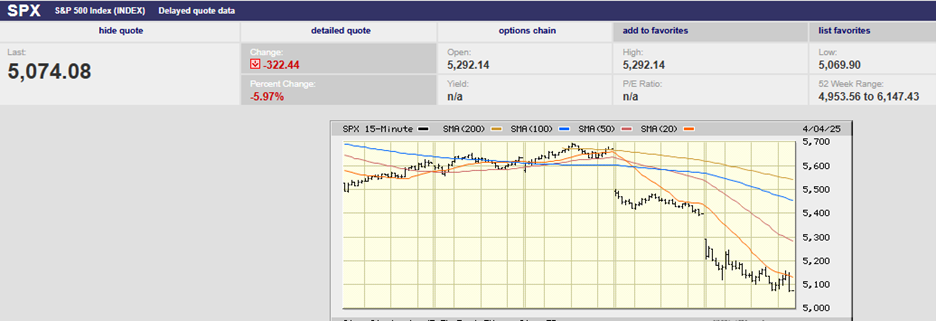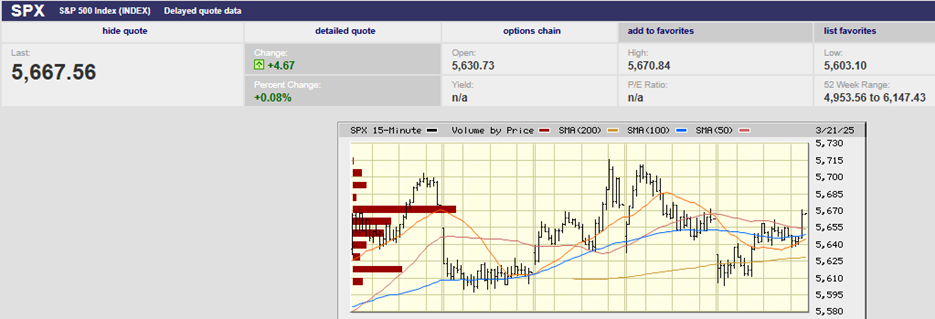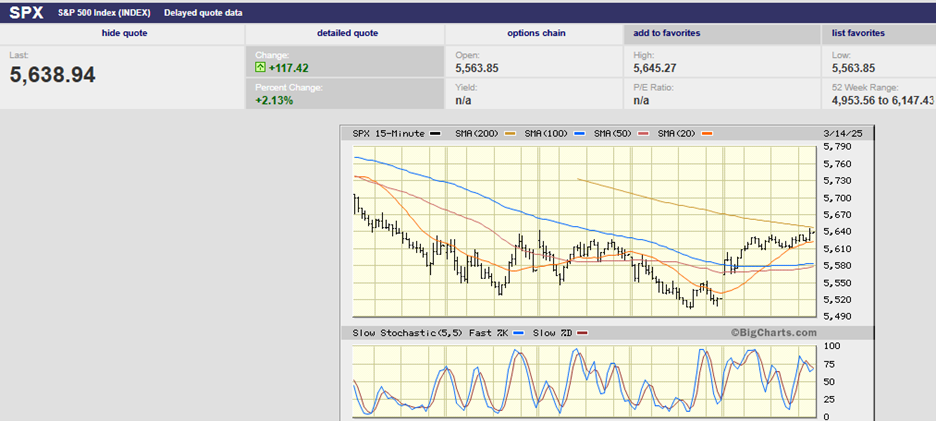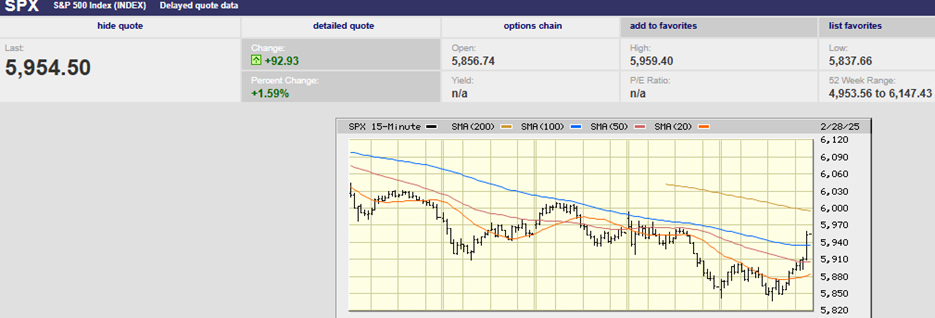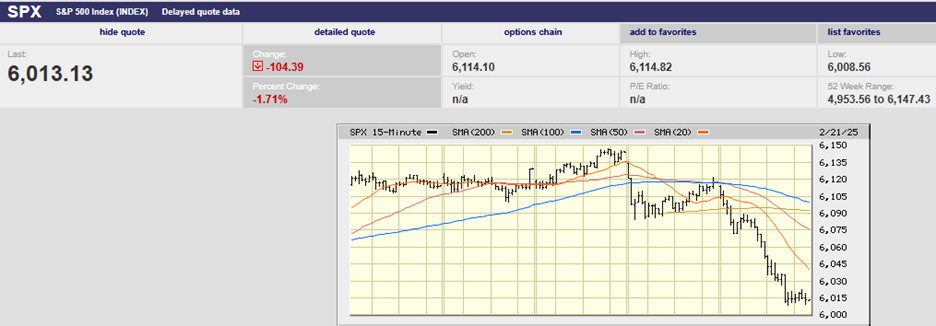Avoid owning the market; focus on owning good companies on sale instead

Market Update
The S&P 500 rose 0.1% last week finishing at 4545.86. The Dow ticked down 0.1% and the Nasdaq finished up 0.7%. We mentioned the 100-day moving average and 4600 as resistance levels in last week’s newsletter. The S&P did make it through its 100-day moving average Monday. It took out the resistance at 4600 on Tuesday. It couldn’t hold those levels though. It closed Wednesday at 4600. The index opened at 4600 on Thursday but failed to move higher. It closed Thursday right below the 100-day moving average.
Friday the S&P opened at the 100-day moving average but couldn’t move above it. The index sold off to 4507.57, which was Friday’s low. A late-day jam saw the S&P rise 41 points in a fifteen-minute window starting at 3:30. The market hit its high for the day of 4548.70 before giving back a few points at day’s end. The late jam pushed the S&P 500 back above the 100-day.
The artificial nature of the late jam higher makes it more likely the market will give back Friday’s gains on Monday. It may be that the S&P is establishing a trading range with the high end around 4600 and the low end around 4200. Several market strategists are forecasting a range-bound market for the next three to six months. For instance, last week we mentioned J.P. Morgan technical strategist Jason Hunter. He sees a range-bound market until this fall. BofA Securities strategist Michael Hartnett believes the current rally will only last until summer when he expects the selling to resume.
A range-bound market isn’t good for people buying the market. It is good for stock pickers looking for bargains. Norwood Economics is tracking eight stocks currently. We plan on buying at prices a bit below their current levels. We sold three energy positions two weeks ago and have money to spend. Norwood Economics is price sensitive and won’t buy just to put cash to work.
Economic Indicators
Wages rose 5.6% year over year in March up from 5.2% in February. The core personal consumption expenditures index was up 5.4% in February. Meanwhile, March’s ISM Manufacturing PMI fell to its lowest level since September 2020. The Manufacturing PMI showed slowing new orders. New orders are a leading indicator.
Non-farm payrolls grew by 431,000 in March. February payroll growth was revised upward to 750,000 from 678,000. March’s jobless rate fell to a post-pandemic low of 3.6%. The bad news came from the March survey of small firms. The survey showed a sharp drop in hiring plans. Also, the employment components of the ISM’s manufacturing and service-sector surveys have weakened in recent months. Further, outplacement firm Challenger, Gray, & Christmas also reported a 40% jump in job cuts in March. The increase in job cuts indicates that job growth may be set to slow.
Financial markets have reacted to the incoming economic data by pricing in a more aggressive Federal Reserve. There’s now a 100% chance of a rate hike at the May Federal Open Market Committee based on the futures market. The futures market also indicates a 71% chance of a half-point increase. It is assigning a greater than 70% chance that the Fed Funds rate will be between 2.5% and 2.75% by year-end.
It seems financial markets are more concerned about the strong inflation numbers than any signs of weakening in the economy. Ending the year with a Fed Funds rate of 2.5% to 2.75% will likely cause stress in both the bond and stock market as the cost of money rises. Expect continued volatility throughout the rest of 2022.
First Quarter Review
The stock and bond market lost money in the first quarter. The S&P 500 was down 5% excluding dividends. The Nasdaq was down 9%. The Russell 2000 small-cap index was off over 6%. The Russell 1000 Growth index lost 9%, while the value index was flat. Bonds were no haven. The Bloomberg Barclays Agg Bond index (AGG) lost 6% in the first quarter.
Individual stocks provided a return if you owned the right stocks. Value stocks did well. Energy stocks were stars. Norwood Economics’ clients earned between 13% and 14% for the most part in their stock portfolios in Q1. Our energy stocks helped greatly. We also had good performance from several healthcare and consumer staples stocks. Norwood did sell three of its seven energy stocks a couple of weeks ago. Energy stocks are no longer cheap. We are looking to redeploy capital into undervalued positions.
Our watch list includes companies in materials, industrials, and the financial and communication services sectors. We are price-sensitive and won't buy unless the price is right. We think we’ll pick up some bargains in 2022, given the expected ongoing volatility in the market.
The S&P 500 gained 3.6% in March, and that rebound has left it trading at 19.6 times 12-month forward earnings. The S&P 500 has traded at around 18x 12-month forward earnings over the last 20 years. It has traded at 15.5x 12-month forward earnings over the longer run. A slowing economy and cost pressures makes it likely that earnings estimates will fall throughout the year. The stock market is vulnerable to another correction in 2022. The bond market will likely provide no safe place to hide. Avoid owning the market and focus on owning good companies on sale instead.
Regards,
Christopher R Norwood, CFA
Chief Market Strategist
